[Charleston's Civil War Trails Markers] Downtown Battlefield
Introduction
Text-to-speech Audio
Images
This historic marker located on the Kanawha River tells the story of the Battle of Charleston
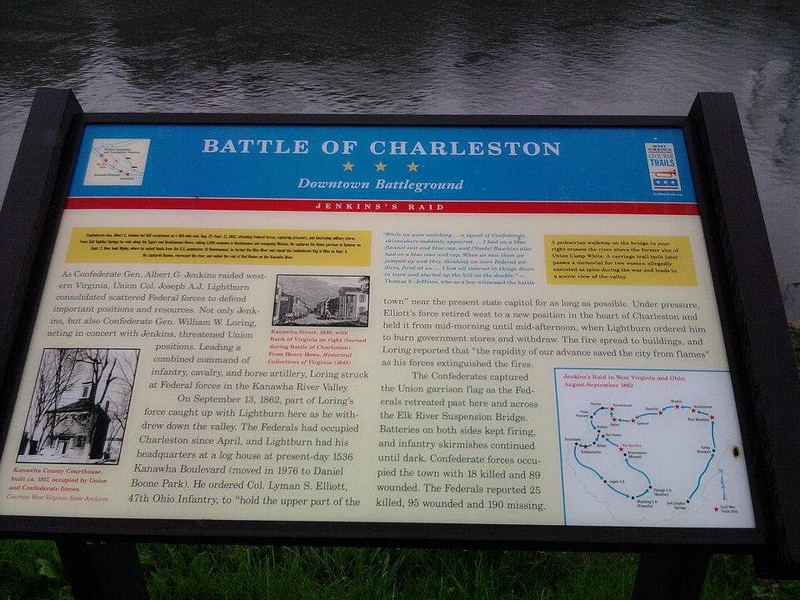
This 1862 clipping from a Boston newspaper tells the story of the burning of Charleston.
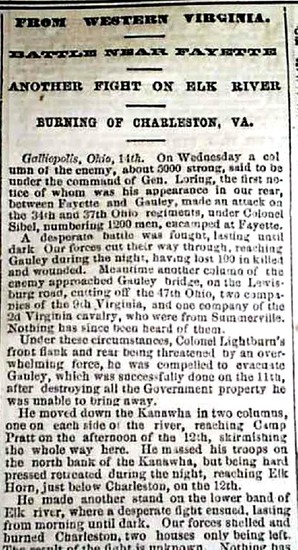
This historic marker located on the Kanawha River tells the story of the Battle of Charleston

This 1862 clipping from a Boston newspaper tells the story of the burning of Charleston.

Union commander Colonel Joseph Andrew Jackson Lightburn, who kept his command intact against overwhelming enemy force through the campaign. West Virginia and Regional History Center.
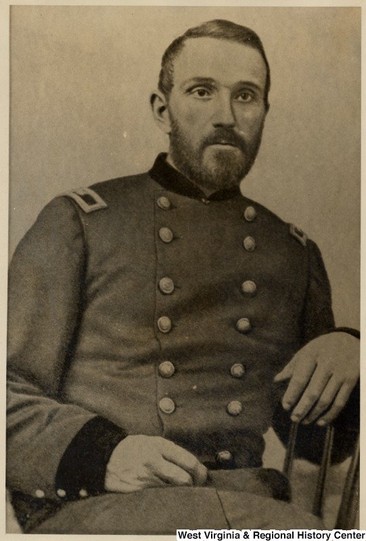
General W.W. Loring, known to his men as "Old Blizzards." Earlier in the war at the Battle of Fort Pemberton, he had exhorted his artillery to "give [the enemy] blizzards." His arm had been lost decades before in the Mexican War.
![General W.W. Loring, known to his men as "Old Blizzards." Earlier in the war at the Battle of Fort Pemberton, he had exhorted his artillery to "give [the enemy] blizzards." His arm had been lost decades before in the Mexican War.](https://storage.googleapis.com/clio-images/medium_8734.118519.jpg)
Colonel George S. Patton, grandfather of the WWII general and commander of the 22nd Virginia Infantry, which included the Kanawha Riflemen. The Riflemen hailed largely from the Charleston area.
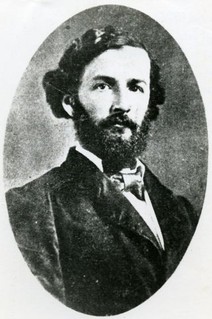
"The Battle of Charleston," currently the most exhaustive book on the battle, by Terry Lowry. 35th Star Publishing, 2016.
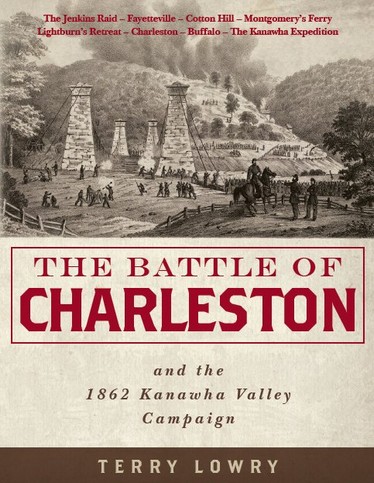
Backstory and Context
Text-to-speech Audio
The end of August 1862 brought despair to the Union cause, as a series of defeats and setbacks rocked the morale of the Union's Army of the Potomac and put it on the defensive around Washington. In a disastrous three day battle on Aug. 28-30, General John Pope's Union army was badly defeated at the Battle of Second Bull Run. Around the same time, General Don Carlos Buell was forced out of Tennessee by Confederate General Braxton Bragg. And a Confederate force under General Kirby Smith was moving virtually unopposed toward Cincinnati.
To make matters worse, a Confederate cavalry raid just before 2nd Bull Run had captured General Pope's dispatch book, revealing to Confederate General-in-chief Robert E. Lee that more than half of the Union troops guarding the Kanawha Valley and western Virginia had been ordered northward to deal with these various crises, leaving an almost token force of 3,500 men in scattered garrisons under Colonel Joseph Lightburn to guard a line of defense from Fayetteville all the way west to the Ohio River.
Seizing the opportunity, Lee ordered General William W. Loring to cross into what is now West Virginia with a sizable force, destroy or capture the Union garrison, then march northward. He was to secure the countryside along the way and prepare to rendezvous with more Confederate troops in the Shenandoah Valley. In capturing the Kanawha Valley, Loring would secure significant military supplies and perhaps even the salt-works near Charleston. Salt was an essential military item of the era, since without refrigeration it was the only way to preserve meat long enough to reach the fighting men at the front.
Loring began his movement on September 6. He attacked a Union detachment near Fayetteville four days later with a force of at least 5,000 men — some estimates have placed it his numbers closer to 10,000. One thing is certain--it was the largest single Confederate force to invade West Virginia during the war.
Federals were able to hold their positions near Fayetteville for a day then pulled back to Gauley Bridge, rendezvousing with other detachments along the way. From there, Lightburn's men conducted a fighting withdrawal up the banks of the Kanawha River, burning supplies as they went. The speed of the retreat meant that Lightburn had to split his forces, with columns traveling up both sides of the river. The Confederates followed suit, with sharp skirmishing all the way to Charleston.
The majority of Lightburn's troops arrived in Charleston by the evening of September 12. But Loring's Confederates came close on their heels, and early on the morning of the 13th, Confederate artillery opened fire on Lightburn's positions near the town. Union surgeon Thomas H. Barton remembers,
"The tale of rout and disaster is always the same. Intense excitement prevailed in the city. The streets were thronged with people, many of whom were preparing to follow our army, or leave the town, for the feared the battle of Charleston was about to be fought over their heads."1
Union cannons attempted to answer, but were heavily outmatched. Loring's troops advanced up both banks of the Kanawha River. A brigade under General McCausland included the 22nd Virginia Infantry regiment, whose Company I were known as the Kanawha Riflemen. They were largely Charleston natives, and took part in some of the sharpest fighting near the present day Capitol Complex. Incidentally, Kanawha Riflemen Memorial Park lies not far from where the action took place.
Lightburn's troops were pushed steadily back through town, holding their ground briefly near present-day downtown Charleston to set fire to a number of buildings that held military supplies. The fire spread to unintended targets and caused the town much damage. Still more destruction was visited upon Charleston in the form of artillery fire, including a cannonball fired by a Confederate battery that passed through the roof of the the MacFarland-Hubbard House (owned at the time, ironically enough, by Confederate John C. Ruby II, who was serving in the Kanawha Riflemen).
Lightburn had wisely pushed the many wagons of his supply train across the Elk River the previous day, and so after setting fire to the abandoned supplies his troops withdrew quickly across the suspension bridge. Under heavy shellfire, they cut the bridge's support cables and collapsed it into the river. The advancing Confederates restlessly prowled the banks looking for boats or a usable ford, but there was no way across. Musket and cannon fire still flew hotly across the Kanawha and Elk Rivers, but the engagement was effectively over.
Lightburn's 700-wagon supply train had already begun the trek northward toward Point Pleasant (intense Rebel artillery fire had kept them from taking the westward route toward the Ohio River). Lighturn kept a rearguard dug in at the Elk until evening, when they extracted themselves and followed in the wake of the weary army. The Battle of Charleston had ended and Lightburn's Retreat, in many ways more famous than the battle itself, had begun.
Lightburn's destruction of the bridge over the Elk had preempted effective Confederate pursuit. Back in Maryland, the tide of Confederate victories was stemmed at Antietam only three days later--Loring was never called northward to join forces with Lee. Six weeks after the Battle of Charleston, Union reinforcements advanced southward and took the city without a fight, as the Rebels backpedaled to the positions they'd occupied before the Kanawha Valley campaign began.
Sources
A. &M 3670, Joseph Andrew Jackson Lightburn, Civil War General, Articles and Letters Regarding Joseph Lightburn, West Virginia and Regional History Center, West Virginia University Libraries.
1. Barton, Thomas H.. Autobioraphy of Dr. Thomas H. Barton.... Charleston, West Virginia. West Virginia printing Company, 1890. 82-87. Digitized by the New York Public Library, 2007.
Cox, Jacob Dolson. April 1861-November 1863: Military Reminiscences of the Civil War. Vol. 1. C. Scribner's sons, 1900. 396-399. Digitized by University of California, 2010.
Emmick, David. Amick Partisan Rangers. Edition 2nd. Flying A Books, 2017. 252-53
Johnson, Flora Smith. The Civil War Record of Albert Gallatin Jenkins, C. S. A.. WVCulture.org. Accessed September 19, 2017. http://www.wvculture.org/history/journal_wvh/wvh8-1.html. West Virginia Archives & History
Peyton, Billy Joe "Battle of Charleston." e-WV: The West Virginia Encyclopedia. 23 June 2014. Web. 08 November 2014.
Rizer, Chris. "Mason County Memories: Lightburn’s Retreat." Point Pleasant Register(Point Pleasant), September 15, 2017. http://www.mydailyregister.com/news/18446/mason-county-memories-lightburns-retreat
Roy Bird Cook, The Civil War Comes to Charleston. West Virginia History, Volume 23, Number 2 (January 1962), pp. 153-167.
